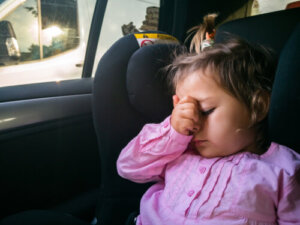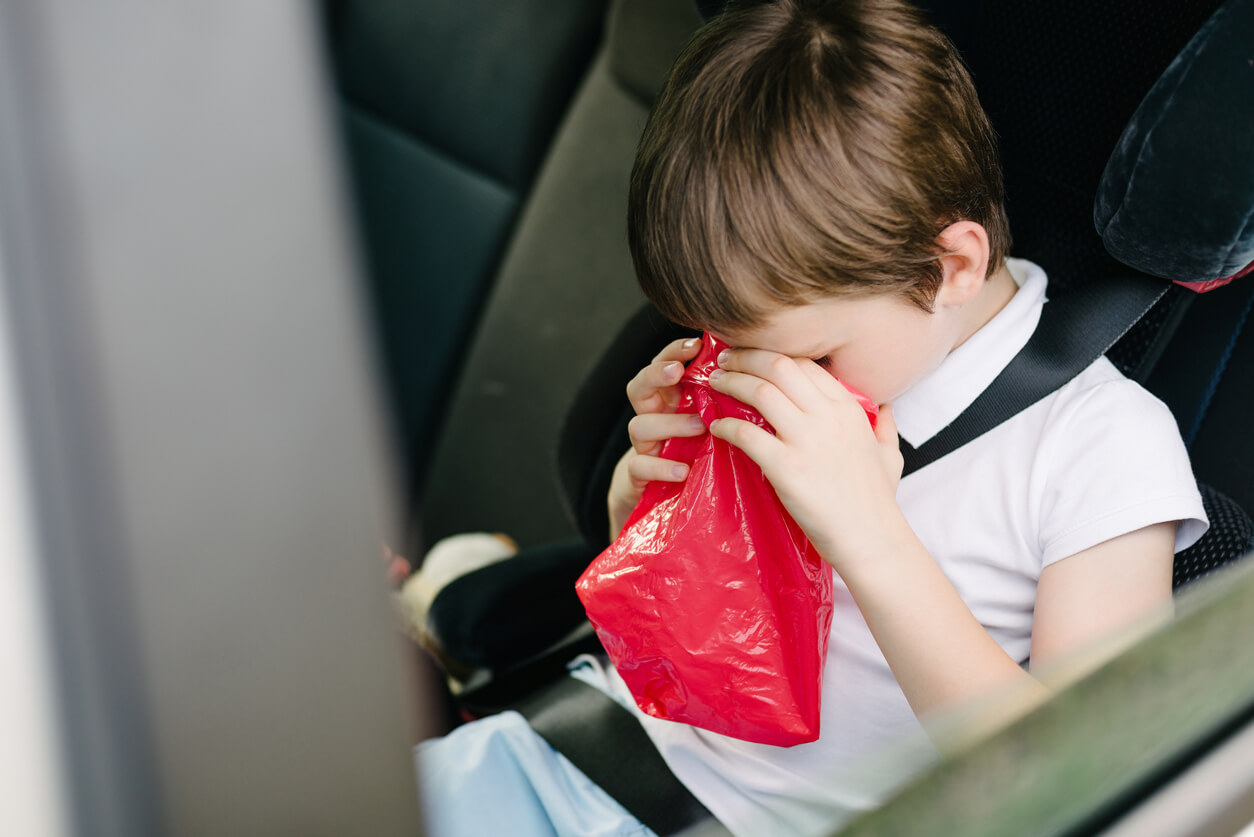10 Tips to Prevent Children from Getting Car Sickness


Written and verified by the nurse Leidy Mora Molina
Preventing children from getting car sickness is one of the priority tasks for parents when planning their vacations. Also known as motion sickness, it occurs when traveling in any transportation vehicle such as cars, boats, trains, or airplanes.
This condition can be maintained throughout childhood and last until about 12 years of age. It then gradually disappears in adulthood. Although it’s more likely to occur on longer trips, it can also be triggered on short journeys, for example, when taking kids to school. Here are 10 tips to prevent children from getting car sickness.
Can we prevent children from getting car sickness?
Car sickness is a condition that appears when the brain receives contradictory information from the inner ears and from other parts of the body, such as the eyes, the nerves of the joints, and the muscles.
This occurs because the sensation of movement received by the eyes isn’t associated with the acceleration perceived by the inner ear (responsible for balance), nor with the position adopted by the body. This is a condition that’s common during childhood due to the immaturity of the brain at that stage to control balance. Moreover, although not all children suffer from it, heredity factors are one of the causes of its occurrence.
Although other causes that trigger episodes of motion sickness haven’t been established, some studies link severe motion sickness to migraine problems, recurrent otitis media, and vestibular deficiencies in children.
Symptoms of motion sickness
Motion sickness is most noticeable in infants as young as 3 years old, although in some children it lasts until age 12. It’s accompanied by symptoms that are quite bothersome, such as the following:
- Pallor
- Cold sweats
- Yawning
- Dizziness
- Salivation
- Nausea and vomiting

Know 10 keys to prevent children from getting car sickness
Fortunately, motion sickness can be avoided. If your little one tends to suffer from it frequently when riding in the car, on the bus, or on a train, take into account the recommendations we’ll share with you below to prevent this annoying symptom.
1. Be careful with meals before having your child ride in the car
Don’t offer abundant meals to your child before going out in the car. On the other hand, don’t let them travel on an empty stomach. In both cases, there’s a risk of motion sickness. The most advisable thing to do is to give them a light snack. Very spicy, greasy, acidic, and strong-smelling foods can also favor this annoying symptom.
Offers a cracker, toast, or dry cereal before beginning your trip. Ginger or lemon candies are a good option when nausea appears or to prevent it. If the trip is long, at each stop you can offer fruit, vegetables, bread, or oatmeal.
2. Adjust the location and position of the child in their seat
The location of the child in the vehicle is key if you want to reduce motion sickness. Keep in mind that, although the front passenger seat is the one that causes the least motion sickness, children can’t ride in the front seat until they are approximately 4 feet, 5 inches tall, that is, until they’re around 12 years old.
For the time being, it’s best for them to ride in the center rear seat, as in this position, the child looks forward instead of to the sides. This limits the visualization of rapid movement.
3. Encourage ventilation inside the car
Heat worsens motion sickness in the car. Therefore, it’s a good idea to keep the windows open to allow air to circulate. Especially when the symptoms of motion sickness begin. If you turn on the air conditioning to reach the back of the car, the recommended temperature is between 70 and 74° Fahrenheit.
If you’re traveling in summer, choose soft and comfortable clothes made of breathable fabric for your child. Remember to put clothes on them that are easy to take off, in case you’ve to make a quick change during the trip.
4. Keep the child distracted during the trip
Play nursery rhymes and encourage your child to sing along. You can also tell them some funny stories, make riddles, and bring their favorite toys. All in an attempt to entertain the child during their trip in the car to avoid motion sickness.
5. Drive carefully
The way you drive significantly influences motion sickness. The driver should drive smoothly and avoid abrupt acceleration or sudden braking. If the road has many curves, you should drive more carefully.
6. Make a few stops
If you’re making a long trip, it’s best to make frequent stops, every 2 or 3 hours, so that the children can get fresh air and stretch their legs. In addition, you can take advantage of the moment to offer food and hydration.

7. Avoid using screens
The use of tablets or cell phones while traveling in the car increases the risk of motion sickness. For this reason, activities in which the child fixes their eyes on a nearby object, such as reading or playing video games, should be avoided.
This is because the brain assumes that the child is standing still and won’t coordinate with the stimuli received by the ear, which will detect movement. Ideally, we should try to make the child focus their sight on distant objects in the landscape, such as clouds or mountains.
8. Look for suitable schedules for long trips
In hot weather, it’s best to travel in the morning or at night, when the atmosphere is cooler. These schedules will also favor the child’s sleep. While the little one sleeps, there’s no risk of motion sickness.
9. Keep your child hydrated
Drinking water prevents motion sickness, so make sure your child stays hydrated during the car ride. Ideally, it should be cold, especially if there’s heat in the air or if they start to feel nauseous. Avoid offering soft drinks and caffeinated beverages.
10. Use medications under pediatric indication
Some medications such as diphenhydramine or dimenhydrinate help prevent car sickness. However, they can cause side effects and make children feel groggy or drowsy. If the problem becomes very frequent, you should consult your pediatrician and, if they consider it pertinent, administer the appropriate dose of these medications.
Another way to prevent motion sickness is with Scopolamine, a drug available in the form of a patch that’s placed behind the ear.
If your child has motion sickness, it’s a good idea to stop the car, make them close their eyes, and lay them on their back in a ventilated place. You can place cold compresses on his forehead to alleviate the symptoms.
Take the necessary elements in case there’s any emergency
Don’t forget to take easily changeable and spare clothes for your child. It’s also important to have some plastic bags and cleaning wipes on hand in case your child feels the urge to vomit. This way, you’ll be able to take care of the situation quickly and continue your trip without major inconveniences.
Preventing children from getting car sickness is one of the priority tasks for parents when planning their vacations. Also known as motion sickness, it occurs when traveling in any transportation vehicle such as cars, boats, trains, or airplanes.
This condition can be maintained throughout childhood and last until about 12 years of age. It then gradually disappears in adulthood. Although it’s more likely to occur on longer trips, it can also be triggered on short journeys, for example, when taking kids to school. Here are 10 tips to prevent children from getting car sickness.
Can we prevent children from getting car sickness?
Car sickness is a condition that appears when the brain receives contradictory information from the inner ears and from other parts of the body, such as the eyes, the nerves of the joints, and the muscles.
This occurs because the sensation of movement received by the eyes isn’t associated with the acceleration perceived by the inner ear (responsible for balance), nor with the position adopted by the body. This is a condition that’s common during childhood due to the immaturity of the brain at that stage to control balance. Moreover, although not all children suffer from it, heredity factors are one of the causes of its occurrence.
Although other causes that trigger episodes of motion sickness haven’t been established, some studies link severe motion sickness to migraine problems, recurrent otitis media, and vestibular deficiencies in children.
Symptoms of motion sickness
Motion sickness is most noticeable in infants as young as 3 years old, although in some children it lasts until age 12. It’s accompanied by symptoms that are quite bothersome, such as the following:
- Pallor
- Cold sweats
- Yawning
- Dizziness
- Salivation
- Nausea and vomiting

Know 10 keys to prevent children from getting car sickness
Fortunately, motion sickness can be avoided. If your little one tends to suffer from it frequently when riding in the car, on the bus, or on a train, take into account the recommendations we’ll share with you below to prevent this annoying symptom.
1. Be careful with meals before having your child ride in the car
Don’t offer abundant meals to your child before going out in the car. On the other hand, don’t let them travel on an empty stomach. In both cases, there’s a risk of motion sickness. The most advisable thing to do is to give them a light snack. Very spicy, greasy, acidic, and strong-smelling foods can also favor this annoying symptom.
Offers a cracker, toast, or dry cereal before beginning your trip. Ginger or lemon candies are a good option when nausea appears or to prevent it. If the trip is long, at each stop you can offer fruit, vegetables, bread, or oatmeal.
2. Adjust the location and position of the child in their seat
The location of the child in the vehicle is key if you want to reduce motion sickness. Keep in mind that, although the front passenger seat is the one that causes the least motion sickness, children can’t ride in the front seat until they are approximately 4 feet, 5 inches tall, that is, until they’re around 12 years old.
For the time being, it’s best for them to ride in the center rear seat, as in this position, the child looks forward instead of to the sides. This limits the visualization of rapid movement.
3. Encourage ventilation inside the car
Heat worsens motion sickness in the car. Therefore, it’s a good idea to keep the windows open to allow air to circulate. Especially when the symptoms of motion sickness begin. If you turn on the air conditioning to reach the back of the car, the recommended temperature is between 70 and 74° Fahrenheit.
If you’re traveling in summer, choose soft and comfortable clothes made of breathable fabric for your child. Remember to put clothes on them that are easy to take off, in case you’ve to make a quick change during the trip.
4. Keep the child distracted during the trip
Play nursery rhymes and encourage your child to sing along. You can also tell them some funny stories, make riddles, and bring their favorite toys. All in an attempt to entertain the child during their trip in the car to avoid motion sickness.
5. Drive carefully
The way you drive significantly influences motion sickness. The driver should drive smoothly and avoid abrupt acceleration or sudden braking. If the road has many curves, you should drive more carefully.
6. Make a few stops
If you’re making a long trip, it’s best to make frequent stops, every 2 or 3 hours, so that the children can get fresh air and stretch their legs. In addition, you can take advantage of the moment to offer food and hydration.

7. Avoid using screens
The use of tablets or cell phones while traveling in the car increases the risk of motion sickness. For this reason, activities in which the child fixes their eyes on a nearby object, such as reading or playing video games, should be avoided.
This is because the brain assumes that the child is standing still and won’t coordinate with the stimuli received by the ear, which will detect movement. Ideally, we should try to make the child focus their sight on distant objects in the landscape, such as clouds or mountains.
8. Look for suitable schedules for long trips
In hot weather, it’s best to travel in the morning or at night, when the atmosphere is cooler. These schedules will also favor the child’s sleep. While the little one sleeps, there’s no risk of motion sickness.
9. Keep your child hydrated
Drinking water prevents motion sickness, so make sure your child stays hydrated during the car ride. Ideally, it should be cold, especially if there’s heat in the air or if they start to feel nauseous. Avoid offering soft drinks and caffeinated beverages.
10. Use medications under pediatric indication
Some medications such as diphenhydramine or dimenhydrinate help prevent car sickness. However, they can cause side effects and make children feel groggy or drowsy. If the problem becomes very frequent, you should consult your pediatrician and, if they consider it pertinent, administer the appropriate dose of these medications.
Another way to prevent motion sickness is with Scopolamine, a drug available in the form of a patch that’s placed behind the ear.
If your child has motion sickness, it’s a good idea to stop the car, make them close their eyes, and lay them on their back in a ventilated place. You can place cold compresses on his forehead to alleviate the symptoms.
Take the necessary elements in case there’s any emergency
Don’t forget to take easily changeable and spare clothes for your child. It’s also important to have some plastic bags and cleaning wipes on hand in case your child feels the urge to vomit. This way, you’ll be able to take care of the situation quickly and continue your trip without major inconveniences.
All cited sources were thoroughly reviewed by our team to ensure their quality, reliability, currency, and validity. The bibliography of this article was considered reliable and of academic or scientific accuracy.
- Academia americana de pediatría (2016). Mi hijo se marea con frecuencia. ¿Qué puedo hacer?. Recuperado de: https://www.healthychildren.org/English/tips-tools/ask-the-pediatrician/Pages/My-son-gets-carsick-frequently.aspx
- Asociación española de pediatría (2020). Dimenhidrinato. Recuperado de: https://www.aeped.es/comite-medicamentos/pediamecum/dimenhidrinato
- Lipson, S. Et al. (2020). Severe motion sickness in infants and children. European Paediatric Neurology Society 2020 Sep;28:176-179. recuperado de: https://pubmed.ncbi.nlm.nih.gov/32682672/
- Manual MSD (2021). Cinetosis. Recuperado de: https://www.msdmanuals.com/es-ve/professional/lesiones-y-envenenamientos/cinetosis/cinetosis
- Sociedad valenciana de pediatría (2019). Consejos para evitar los mareos de los niños en el coche. Recuperado de: https://socvalped.com/patologias/2019/consejos-para-evitar-los-mareos-de-los-ninos-en-el-coche/
- Revista mayo (2022). ¿Cuál es la causa del mareo producido por el movimiento del automóvil y cómo puedo prevenirlo?. Recuperado de: https://www.mayoclinic.org/es-es/healthy-lifestyle/childrens-health/expert-answers/car-sickness-in-children/faq-20057876
This text is provided for informational purposes only and does not replace consultation with a professional. If in doubt, consult your specialist.








